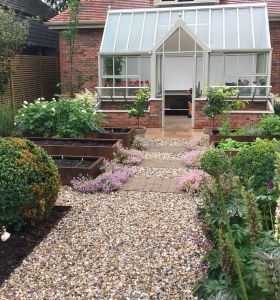Video Transcript
Hi, today’s video is about planting plans and what to expect. We’re going to revisit a scheme that we’ve looked at previously and also look at an example of a smaller courtyard garden as well.
Planting Plans for Large Country Garden
The scheme that we’re looking at is quite a large sort of country estate garden. And it would be impossible to look at all of the different planting areas on one plan.
And that’s purely because the planting plans are incredibly detailed. And require layers of complexity with regard to the seasonality of the plants that are going to be in those borders and how they all work together. When we’re putting planting plans together, and when we’re putting the concept together, right from the off, we’re looking, we’re thinking about the space.
Planting Plans for Courtyard Area
So this area here, we’re zooming in on one particular area. And then again, what we’re looking to do here is we’re going to specifically have a look at this area today, which is the small sort of crucifix sort of courtyard space to the north of the property there.
So in the visuals that we put together for this concept design it gives you a good idea of the sort of thinking that we’re putting into the planting right from the off when we’re thinking about the spatial arrangement of the scheme and the views, framing views, what we’re going to be looking at, what’s going to be the points of interest.
But when we actually get down to the nuts and bolts of putting the scheme together, we have to decide each of these different plants as a component of the scheme. And what we’re going to look at today is just this little composition here of the small tree, the catalpa, and the under planting around it.
Small Composition Planting Plans
So the planting plan for this particular area, and this is fairly typical for a planting border. Here we’ve got a little sort of location map at the top there, and the red box is showing us what we’re looking at in the expanded view here of the actual planting plan.
And if we look at each of these square beds. Because of the nature of the design the bed is a repeated element so that you’ve got a continuity within the design and that’s a very deliberate design decision that we’re making right at that moment regarding the plants that we’re then going to be putting in there.
Plant Selection
When we’re selecting our plants, we’re obviously thinking about soil conditions. We’re thinking about the suitability and the light available to those plants at various times of the day. And also at various times of the year. Because in the height of summer, this whole courtyard space will be in full sun.
But in the winter, it’s likely that this side of the planting will suffer from some shade. So the planting here, although it needs to match the planting here, needs to use plants that will tolerate both full sun and partial shade in this particular environment. So the selection of plants is quite critical.
Tree Selection
If we look at the tree selection here, when we’re looking at sort of a specimen tree to go in to any scheme, and this is just one example here, we’re looking at a particular variety, which is Catalpa bignonioides ‘nana’, which has got a nice green leaf, quite a big heart shaped leaf. It’s a lovely tree in the summer.
In the winter it loses its leaves. Now, some clients may have a preference for an evergreen shape. Some clients might have a preference for something that flowers. We, as part of the brief for the scheme, we will endeavour to pick and go through the planting plans to ensure that we’re the most appropriate plants are being put in position for each of the different areas on the scheme.
So you can see up in the top here, we’ve got those four trees in this position, but we’ve also got some other trees through here. So when we’re putting the plan together, we’ll be thinking about the long view through here and perhaps creating some contrast between the foliage of the bigger tree here and the foliage of these trees.
So there’s multiple things that we’re thinking about when we’re putting together a planting plan. In this particular instance, you’ve got some evergreen low grasses and they are interplanted with some early sort of spring flowering Allium bulbs, which give a nice pop of color. And those are then followed on later on by some Geums which are interplanted in between them, which will pop up with this sort of lovely apricot flowers, which will sort of just create a little veil underneath the branches of the catalpa there.
Planting Map
You’ll notice that with the planting here, we’re basically creating a map of the plants that we’re going to be supplying, and we’re looking at the number of the plants that we need, and we’re also looking at this very specific Latin name of that plant so that there’s no ambiguity about what plant we’re ordering from the nursery because common names for plants can confuse things considerably.
Planting Schedule
So all of these plants will get amalgamated into a planting schedule. So once we’ve actually decided what plants are going in, we then have to decide what size do we want them at? And what’s the most appropriate. Not only that, we have to check out the availability of those plants, because there’s no point in us suggesting things in a planting plan which we can’t get hold of for you.
So it’s very, very important for us to be able to put a schedule together, that is of realistic plants that we can get hold of for you. We endeavor to do that as part of the design process before presenting a planting plan to a client, it will be checked for availability, as well as sizing prior to presentation.
So in this particular instance, the plants here would go into a planting schedule, and we would look to specify a particular size for them. Where we’re dealing with specimen plants, such as the catalpas, or the trees in this instance, we may well ask the nursery to give us, some photographic options, and or we may hand pick those specimens, as well at the nursery, depending on the importance of that particular tree.
We’ve got an option to buy it with a half height stem or a full height stem, depending on the effect that we’re looking to create. We’ve also got an option to buy them as pot grown. In the winter we can buy them as, root balled from the continent and they would come in via specialist nurseries, as a root balled plant which would go in and obviously with a tree they would get staked.
Small Garden Planting Plans
So that’s a sort of an overview of the planning of this sort of larger scheme. On a sort of more straightforward level. On a smaller sort of courtyard garden such as this one, we’ve got the layout defined in a similar way.
What we’ve got here is we’ve got the planting labeled, we’ve got the number of plants going in, and obviously this is a much more complicated scheme, but it’s on a much smaller scale, so we are able to put all of this on one plan. Obviously, the planting images here relate to all of the different plants that we’re proposing within this scheme.
Now, the advantage of having a detailed plan like this is it allows us to specify plants appropriately for a growth period which allows the appropriate spacing to be put in so that the the garden is not over planted on day one.
It’s very easy to put too many plants into a garden and then three to five years down the line, find that they’ve outgrown their space. This is quite a wasteful approach to planting and we try to avoid that with appropriate spacing of the plants.
Plants for Shade
As I mentioned before we’re very much looking to find appropriate plants for the aspect so in this particular example this is a very shady area at the bottom of the garden. And we’ve got appropriate plants such as hellebores, Epimediums, Pachysandras and so on in this area.
Plants for Sunny Areas
Whereas at the top here is very sunny border and we’ve got things like agapanthus and astrantias in this top border. So it’s very much about, placing the right plant in the right place to ensure that you get value for money, both in terms of the spacing, but also in terms of the longevity and survival of those plants.
Plan for Construction and Maintenance
The other thing about having a planting plan is that it gives a clear map for the actual construction staff to use actually to put the plants in the right place. And finally long after we’ve gone you’ve got a document that can be used for whoever’s maintaining the garden to understand what plants have been put into the garden and where those plants exist.
Not everybody is an expert on all of the different plants and to be able to know and identify from the images and from the Latin names what plants are in there gives the people who are maintaining the garden, and that may be yourselves or it may be a professional gardening company, it gives them the opportunity to add and amend and to the planting plan as time goes on.
You may be gifted plants and they could be added into the scheme. So that’s a really quick overview of planting plans. There’s a lot of detail and a lot of time spent on creating these and hopefully you found that useful. Thanks very much.
Contact Us Today
Contact us today to discuss how we can help you design the perfect garden to suit your personality and lifestyle.






